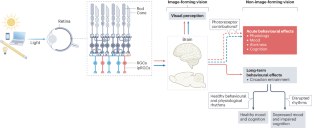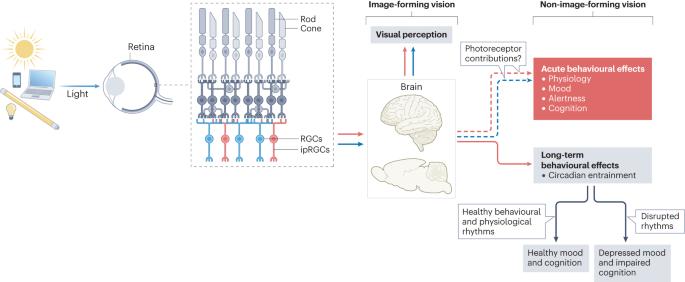The cognitive impact of light: illuminating ipRGC circuit mechanisms
IF 28.7
1区 医学
Q1 NEUROSCIENCES
引用次数: 0
Abstract
Ever-present in our environments, light entrains circadian rhythms over long timescales, influencing daily activity patterns, health and performance. Increasing evidence indicates that light also acts independently of the circadian system to directly impact physiology and behaviour, including cognition. Exposure to light stimulates brain areas involved in cognition and appears to improve a broad range of cognitive functions. However, the extent of these effects and their mechanisms are unknown. Intrinsically photosensitive retinal ganglion cells (ipRGCs) have emerged as the primary conduit through which light impacts non-image-forming behaviours and are a prime candidate for mediating the direct effects of light on cognition. Here, we review the current state of understanding of these effects in humans and mice, and the tools available to uncover circuit-level and photoreceptor-specific mechanisms. We also address current barriers to progress in this area. Current and future efforts to unravel the circuits through which light influences cognitive functions may inform the tailoring of lighting landscapes to optimize health and cognitive function. A direct influence of light exposure on cognition and behaviour, beyond that associated with circadian rhythms, has been reported. Mahoney and Schmidt consider the evidence for light’s effects on aspects of cognitive neurobehavioural performance, summarize current understanding of the underlying cellular and circuit mechanisms and point to future directions for this field of research.


光对认知的影响:ipRGC 电路机制的启示
光在我们所处的环境中无处不在,它长期影响着昼夜节律,影响着日常活动模式、健康和工作表现。越来越多的证据表明,光的作用也独立于昼夜节律系统,直接影响生理和行为,包括认知。光照能刺激大脑中与认知有关的区域,似乎能改善广泛的认知功能。然而,这些影响的程度及其机制尚不清楚。本征光敏视网膜神经节细胞(ipRGCs)已成为光影响非图像形成行为的主要渠道,也是介导光对认知的直接影响的主要候选者。在此,我们回顾了人类和小鼠对这些影响的理解现状,以及用于揭示回路级和光感受器特异性机制的可用工具。我们还讨论了目前该领域取得进展的障碍。目前和未来为揭示光影响认知功能的回路所做的努力,可为定制照明景观提供信息,从而优化健康和认知功能。
本文章由计算机程序翻译,如有差异,请以英文原文为准。
求助全文
约1分钟内获得全文
求助全文
来源期刊

Nature Reviews Neuroscience
NEUROSCIENCES-
自引率
0.60%
发文量
104
期刊介绍:
Nature Reviews Neuroscience is a multidisciplinary journal that covers various fields within neuroscience, aiming to offer a comprehensive understanding of the structure and function of the central nervous system. Advances in molecular, developmental, and cognitive neuroscience, facilitated by powerful experimental techniques and theoretical approaches, have made enduring neurobiological questions more accessible. Nature Reviews Neuroscience serves as a reliable and accessible resource, addressing the breadth and depth of modern neuroscience. It acts as an authoritative and engaging reference for scientists interested in all aspects of neuroscience.
 求助内容:
求助内容: 应助结果提醒方式:
应助结果提醒方式:


